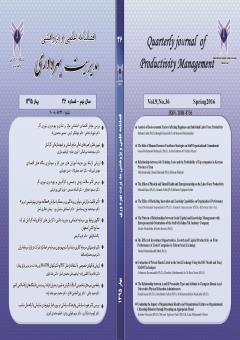ارزیابی ارتباط بین هزینه آموزش های حین کار و سودآوری بنگاه های اقتصادی (مطالعه موردی: واحدهای تولیدی برگزیده استان کرمان درسال 94)
الموضوعات :مهدی امیرزاده 1 , احمد جعفرنژاد 2 , حسن خوبیاری 3
1 - دانشجوی دکتری مدیریت تولید وعملیات دانشگاه تهران،ایران
2 - استاد گروه مدیریت صنعتی دانشگاه تهران،ایران
3 - دانشجوی دکتری مدیریت بازرگانی دانشگاه تهران
الکلمات المفتاحية: هزینه, آموزش حین کار, سود آوری, واحد تولیدی,
ملخص المقالة :
امروزه نگاه به آموزش به عنوان یکی از شاخص های رشد و توسعه درکشورها مورد توجه جدی قرارگرفته است.انجام فعالیت های آموزش درحین کار به همراه انتخاب درست و بجای محتوای آنها از جنبه های مختلف می تواند فوایدی دوجانبه برای کارمند وکارفرما به همراه داشته باشد.باتوجه به رقابت روز افزون شرکت ها و احساس ضرورت جهت ارتقای هرچه بیشتر توانمندی ها، این موضوع در شرکت های تجاری و تولیدی روز به روز جایگاه ارزشمند تری می یابد.دربسیاری از مدلهای رشد و تعالی سازمانی شاخص آموزش به عنوان یکی از پارامترهای مهم مورد توجه ارزیابان و بررسی کنندگان قرارگرفته است.اهمیت این موضوع از آنجایی است که تاثیرات فراوان آن درخروجی های مهم شرکت اثبات شده است.دراین مقاله شرکت های برگزیده استان کرمان درسال 1394 براساس اطلاعات اخذشده مربوط به سال 1393مورد بررسی قرارگرفتند و ارتباط بین هزینه هایی که درامر آموزش داشتند و سودناخالص قبل ازکسرمالیات آنها مورد تحلیل قرارگرفت. نتایج تحقیق نشان می دهد بین هزینه های آموزش و سودناخالص قبل ازکسرمالیات شرکت ها رابطه معنادار وجود دارد.
-
- Pakdel, R. (2004), “Management and leadership training organization (strategic Systmy_ attitude", Tehran, Moein Administration Institute.
- Soltani, E. (2006), “Training needs assessments and engagement in learning organizations, Isfahan”, Tehran, Pillars of Knowledge Publications.
- Hafeznia, M. (2005), “Introduction to human science research procedares”, Tehran.
- Chaychi, P. (2002), “Methods of training”, Tehran.
- Sarmad, and et all. (2005), “Behavioral science research methods”, Tehran, Aghah Publishing.
- Sam Ksniyan, R. Raabi, M. (2005), “Planning, human resource training (principles and processes)”, Tehran, Mehrbana.
- Fathi, K. (2002), “Needs assessment, models and techniques”, Tehran, Ayyig Publishing.
- Eydi, A. “Measuring the effectiveness of training courses”, MA thesis in Educational Management, University of Semnan, address available online at:
http://www.ensani.ir/storage/Files/20110214182839-s%20%285%29.pdf
- Abdel-Wahab,M. Andrew R. J. Dainty, Stephen.(2008),” An exploration of therelationship between training grants and profitability of UK construction companies” International Journal of Training and Development No12:3
- Cosh, A., Hughes, A., Bullock, A. and Potton, M. (2003), ‘The Relationship between Training and Business Performance’, Research Report No. 454 (London: Department for Education and Skills (DfES)).
- Dearden, L., Reed, H. and Van Reenen, J. (2000), Who Gains When Workers Train? Training and Corporate Productivity in a Panel of British Industries (London: The Institute for Fiscal Studies and University College).
- Fleetwood, S. and Hesketh, A. (2006), Living (and dying) by numbers: the continuing weakness of the HRM-organisational performance link. Working paper, Institute for Advanced Studies, Lancaster
- Guest, D. E., Michie, J. and Conway, N. (2003), ‘Human resource management and corporate performance in the UK’, British Journal of Industrial Relations, No.41.pp 291–314.University. Available at www.lancs.ac.uk/ias/researchgroups (accessed 10 February 2006).
- Kalili .M, Mohseni. A. (.2012), The role of practical training in productivity and profitability of organizations in the Third Millennium. Social and Behavioral Sciences No47.pp 1970 – 1975
- Learning and Skills Council (LSC) (2007), Skills in England. Available at research.lsc.gov.uk
- Wall, T. D. and Wood, S. J. (2005), ‘The romance of human resource management and business performance, and the case for big science’, Human Relations,No 58, pp 429–62
_||_
-
- Pakdel, R. (2004), “Management and leadership training organization (strategic Systmy_ attitude", Tehran, Moein Administration Institute.
- Soltani, E. (2006), “Training needs assessments and engagement in learning organizations, Isfahan”, Tehran, Pillars of Knowledge Publications.
- Hafeznia, M. (2005), “Introduction to human science research procedares”, Tehran.
- Chaychi, P. (2002), “Methods of training”, Tehran.
- Sarmad, and et all. (2005), “Behavioral science research methods”, Tehran, Aghah Publishing.
- Sam Ksniyan, R. Raabi, M. (2005), “Planning, human resource training (principles and processes)”, Tehran, Mehrbana.
- Fathi, K. (2002), “Needs assessment, models and techniques”, Tehran, Ayyig Publishing.
- Eydi, A. “Measuring the effectiveness of training courses”, MA thesis in Educational Management, University of Semnan, address available online at:
http://www.ensani.ir/storage/Files/20110214182839-s%20%285%29.pdf
- Abdel-Wahab,M. Andrew R. J. Dainty, Stephen.(2008),” An exploration of therelationship between training grants and profitability of UK construction companies” International Journal of Training and Development No12:3
- Cosh, A., Hughes, A., Bullock, A. and Potton, M. (2003), ‘The Relationship between Training and Business Performance’, Research Report No. 454 (London: Department for Education and Skills (DfES)).
- Dearden, L., Reed, H. and Van Reenen, J. (2000), Who Gains When Workers Train? Training and Corporate Productivity in a Panel of British Industries (London: The Institute for Fiscal Studies and University College).
- Fleetwood, S. and Hesketh, A. (2006), Living (and dying) by numbers: the continuing weakness of the HRM-organisational performance link. Working paper, Institute for Advanced Studies, Lancaster
- Guest, D. E., Michie, J. and Conway, N. (2003), ‘Human resource management and corporate performance in the UK’, British Journal of Industrial Relations, No.41.pp 291–314.University. Available at www.lancs.ac.uk/ias/researchgroups (accessed 10 February 2006).
- Kalili .M, Mohseni. A. (.2012), The role of practical training in productivity and profitability of organizations in the Third Millennium. Social and Behavioral Sciences No47.pp 1970 – 1975
- Learning and Skills Council (LSC) (2007), Skills in England. Available at research.lsc.gov.uk
- Wall, T. D. and Wood, S. J. (2005), ‘The romance of human resource management and business performance, and the case for big science’, Human Relations,No 58, pp 429–62


